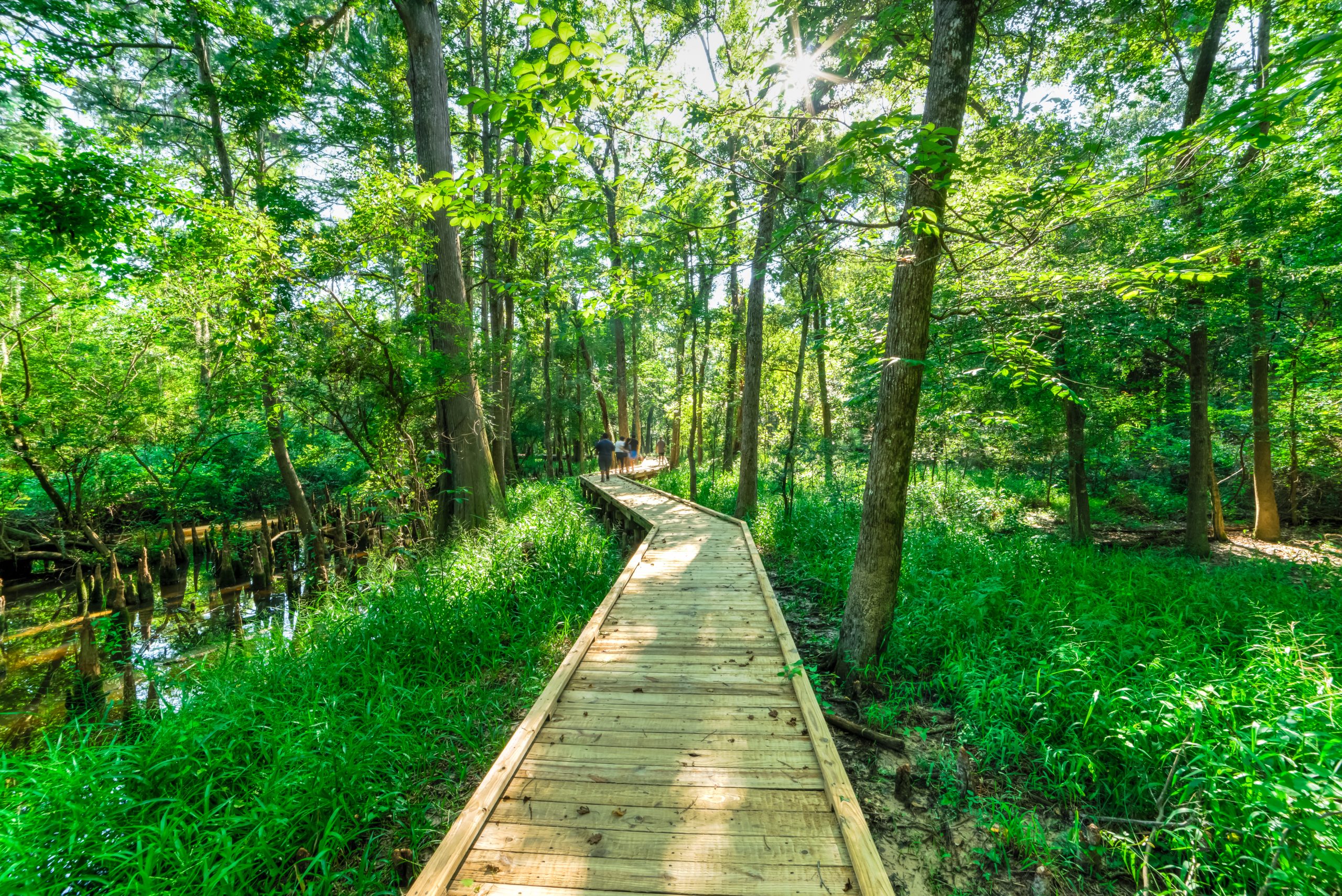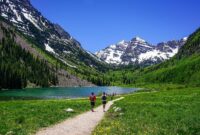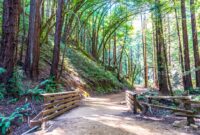Nature walking trails near me offer a fantastic opportunity to connect with the natural world, providing both physical and mental rejuvenation. This exploration delves into finding the perfect trail based on your location, fitness level, and preferred environment. Whether you seek a gentle stroll through a woodland path or a challenging hike up a mountain trail, understanding the factors involved in selecting the ideal route is crucial for a safe and enjoyable experience.
We will cover key aspects, from defining “near me” geographically and understanding various trail types to accessing reliable information and prioritizing safety. We’ll also look at enhancing the overall user experience, including user reviews and improved search functionalities, to ensure your next nature walk is both fulfilling and stress-free.
Defining “Near Me”
Determining the precise meaning of “near me” in the context of nature walking trails requires careful consideration of geographic location and user expectations. This seemingly simple phrase presents a surprisingly complex challenge for developers of location-based services, as it relies heavily on individual interpretation and technological capabilities. The effective implementation of a “near me” search hinges on accurately interpreting user location and translating that into a meaningful geographic radius for the search.
The geographic radius used for a “near me” search significantly impacts the results. A smaller radius, for example, 5 kilometers, will likely return a more focused set of trails very close to the user’s location. This is ideal for users who prefer short, convenient walks. Conversely, a larger radius, perhaps 50 kilometers, will broaden the search considerably, including trails that may require significant travel time. This approach is suitable for users willing to explore further afield or those seeking a wider variety of trails. The optimal radius depends entirely on the user’s preferences and the density of trails in the surrounding area. A densely populated urban area might yield sufficient results within a smaller radius compared to a sparsely populated rural region where a larger radius is necessary to return relevant results.
Geographic Radius and Search Results
Different radii produce vastly different results. A 1-kilometer radius might only reveal trails within immediate walking distance, while a 20-kilometer radius could uncover trails across a significant portion of a city or county. The variation in results directly reflects the changing scope of the search area. A user searching for a quick lunchtime walk will benefit from a smaller radius, whereas someone planning a day-long hike would prefer a larger one. The impact on the number of results is also substantial; a larger radius will almost always return more results, potentially overwhelming the user with choices. Conversely, a smaller radius might return too few options, leading to disappointment. Therefore, offering users adjustable radius parameters allows for a personalized and more effective search experience.
Challenges in Defining “Near Me” for Users
Defining “near me” presents challenges due to varying levels of geographic awareness among users. Some users possess a strong sense of local geography, accurately estimating distances and travel times. For them, a default radius might be sufficient. Others may have limited local knowledge, relying heavily on the application to provide relevant results. These users might require a more sophisticated system that takes into account factors like preferred transportation methods (walking, driving, cycling) and estimated travel time, rather than simply relying on a fixed radius. For example, a user who is unfamiliar with the area might interpret “near me” differently than a local resident. The same 5-kilometer radius could feel too small or too large depending on the user’s experience and understanding of the surrounding area.
Mapping Service Approaches to Location-Based Searches
Different mapping services employ varying approaches to handle location-based searches. Google Maps, for instance, uses a combination of user location data, algorithms, and map data to suggest relevant locations. It often provides results in a visually intuitive manner, with distance prominently displayed. Apple Maps offers similar functionality, prioritizing relevance and distance. Specialized hiking apps often incorporate elevation data and trail difficulty ratings into their location-based searches, offering a more refined approach tailored to the specific needs of hikers. These services illustrate the diverse methods used to translate the ambiguous “near me” into concrete search results, highlighting the complexities involved in providing a truly personalized experience.
Types of Nature Walking Trails
Nature walking trails offer diverse experiences, catering to various fitness levels and preferences. Understanding the different types of trails available helps ensure a safe and enjoyable outing, allowing individuals to select a trail that matches their abilities and expectations. This section will categorize trails by difficulty and type, highlighting key features and potential challenges.
Trail Difficulty Levels
Trail difficulty is typically categorized into easy, moderate, and difficult levels. This classification considers factors such as terrain, elevation changes, and trail length.
Easy trails are generally flat or have minimal elevation gain, with well-maintained surfaces like packed dirt or paved paths. They are suitable for individuals of all fitness levels, including families with young children or those with limited mobility. Distances typically range from 1 to 3 miles. An example would be a paved trail along a riverbank, offering gentle gradients and scenic views.
Moderate trails present some elevation changes and may include uneven terrain such as rocky sections or slightly steeper inclines. These trails are suitable for individuals with a reasonable level of fitness. Distances usually range from 3 to 6 miles. A trail winding through a forest with some gentle hills and roots would be considered moderate.
Difficult trails involve significant elevation gain, challenging terrain such as steep inclines, rocky surfaces, and potentially loose gravel. These trails require a good level of fitness and stamina. Distances can exceed 6 miles and often involve considerable elevation changes. A mountain trail with steep ascents and descents, potentially involving scrambling over rocks, would fall into this category.
Trail Types
Nature trails can be broadly categorized into several types, each offering a unique experience and presenting different challenges.
| Trail Type | Features | Potential Challenges | Accessibility Considerations |
|---|---|---|---|
| Woodland | Shaded paths, diverse flora and fauna, varied terrain (from flat to hilly) | Roots, uneven surfaces, potential for mud or slippery conditions, limited visibility in dense areas | Trails may be uneven; wider, well-maintained paths are more accessible. |
| Coastal | Ocean views, sandy or rocky beaches, potential for cliffs and coastal vegetation | Sand can be difficult to walk on, potential for strong winds, exposure to the elements, uneven terrain near cliffs | Paved or boardwalk sections can improve accessibility. Steep inclines near cliffs present significant challenges. |
| Mountain | High elevation, stunning views, challenging terrain (steep inclines, rocky surfaces) | Steep ascents and descents, altitude sickness, potential for hazardous weather conditions | Many mountain trails are inaccessible to those with mobility impairments due to steep inclines and uneven terrain. |
| Urban | Parks, green spaces within cities, often paved or well-maintained paths | Crowds, noise pollution, potential for uneven surfaces in less maintained areas | Generally more accessible than other trail types due to paved surfaces and proximity to amenities. |
Trail Accessibility Features
Accessibility for users with disabilities is a crucial consideration when designing and maintaining nature trails. Features that improve accessibility include paved or compacted surfaces, gentle gradients, wider trail widths to accommodate wheelchairs and other mobility aids, accessible restrooms and parking, and clear signage with Braille and large print. Some trails incorporate boardwalks or ramps to navigate uneven terrain. However, many trails, especially those in more rugged areas, may inherently present challenges to accessibility due to the nature of the terrain. It is vital to check trail descriptions and reviews for accessibility information before embarking on a hike.
Trail Information and Resources
Finding and utilizing reliable information is crucial for a safe and enjoyable nature walk. Understanding how to access and interpret trail data will enhance your experience and minimize potential risks. This section details the formats for presenting trail information, various organizational methods, and a comparison of different information sources.
Structured Trail Information Format
A standardized format for presenting trail information ensures clarity and ease of comparison. The following table exemplifies a structured approach, suitable for displaying information concisely and efficiently. Using a table allows for quick visual comparison of multiple trails.
| Trail Name | Location | Length (miles) | Difficulty |
|---|---|---|---|
| Whispering Pines Trail | Redwood National Park, CA | 5.2 | Moderate |
| Eagle Peak Trail | Rocky Mountain National Park, CO | 7.8 | Strenuous |
| Ocean View Trail | Acadia National Park, ME | 2.1 | Easy |
| Willow Creek Trail | Grand Canyon National Park, AZ | 10.5 | Difficult |
| Elevation Gain (ft) | Notable Features | Points of Interest | Additional Notes |
|---|---|---|---|
| 1200 | Forest, River Views | Old Growth Redwoods, Scenic Overlook | Permit required |
| 2500 | Mountain Views, Alpine Tundra | Eagle Peak Summit, Wildflower Meadows | High altitude, check weather |
| 200 | Ocean views, Coastal Scenery | Granite cliffs, tide pools | Can be crowded |
| 3000 | Canyon Views, Desert Landscape | South Rim viewpoints, diverse flora | Bring plenty of water |
Organizing Trail Information
Trail information can be organized in several ways to suit different needs. Alphabetical ordering is useful for quick reference. Organizing by difficulty allows hikers to select trails appropriate for their fitness level. Proximity-based organization is ideal for finding trails close to a specific location.
Sources of Trail Information
Several sources provide trail information, each with varying levels of reliability and detail.
Government websites (e.g., National Park Service, state park websites) generally offer reliable and detailed information, including maps, trail descriptions, and regulations. However, they may lack real-time updates on trail conditions.
Mapping apps (e.g., AllTrails, Gaia GPS, Hiking Project) provide detailed maps, user reviews, and often real-time trail conditions. While generally reliable, the accuracy of user-submitted information can vary.
Hiking blogs and forums offer personal perspectives and reviews, which can be valuable but should be considered alongside other sources. The reliability and accuracy of this information can be inconsistent.
Local communities (e.g., hiking clubs, local shops) can provide valuable insights into local trails, including hidden gems and current trail conditions. This information is often highly localized but may lack the breadth of coverage found in other sources.
Enhancing the User Experience
A superior nature walking trails search engine hinges on providing users with a seamless and informative experience. This involves not only readily accessible trail data but also the integration of user-generated content and sophisticated filtering options to personalize the search and discovery process. A well-designed interface is crucial for intuitive navigation and a positive overall user journey.
Effective filtering and personalized search results are paramount to a positive user experience. By offering granular control over search parameters, users can efficiently locate trails that match their specific needs and preferences. This empowers them to find trails that perfectly suit their fitness level, desired length, accessibility requirements, and preferred scenery.
Filtering Options
Comprehensive filtering options significantly enhance user experience. Users should be able to filter trails based on criteria such as distance, elevation gain, difficulty level (easy, moderate, strenuous), trail type (loop, out-and-back, point-to-point), surface type (paved, gravel, dirt), amenities (restrooms, water fountains, parking), and proximity to specific points of interest (e.g., lakes, waterfalls, historical sites). Furthermore, allowing users to filter by dog-friendliness, accessibility for wheelchairs or strollers, and seasonal availability enhances inclusivity and caters to diverse needs. AllTrails, for instance, utilizes a robust filtering system incorporating many of these features.
User Reviews and Photo Galleries
Integrating user-generated content, such as reviews and photos, transforms a simple trail database into a vibrant community hub. User reviews provide invaluable insights into trail conditions, safety concerns, and overall trail experience. High-quality photographs vividly showcase the trail’s scenery and atmosphere, allowing potential hikers to virtually preview the trail before embarking on their journey. This participatory approach enhances the credibility and reliability of trail information, providing a more authentic and engaging experience. Consider websites like Yelp, where user reviews and photos are integral to the user experience.
Integrating User-Generated Content
Integrating user-generated content requires a well-structured system for submission, moderation, and display. A user-friendly submission form allows users to easily upload photos and write reviews, potentially including ratings for various aspects of the trail. A moderation system is essential to ensure the quality and accuracy of the content, filtering out inappropriate or irrelevant submissions. The system should display photos in a visually appealing gallery format, potentially with options for sorting and filtering by date, rating, or other criteria. Reviews should be displayed chronologically or sorted by rating, potentially with options for filtering based on length or keywords. The integration should also incorporate mechanisms for responding to reviews, fostering a sense of community and addressing user concerns.
Examples of Successful User Interfaces
Several successful applications demonstrate effective user interface design for displaying trail information. AllTrails employs a clean, intuitive interface with clear mapping, detailed trail descriptions, elevation profiles, and user-generated photos and reviews. The interface prioritizes visual clarity and easy navigation, making it simple for users to find and explore trails. Another example is Hiking Project, which offers a similar level of detail and user-generated content integration, with a strong focus on community interaction and collaborative trail maintenance. These platforms showcase the importance of a well-designed interface for maximizing user engagement and satisfaction.
Concluding Remarks
Discovering and enjoying nature walking trails near you should be a seamless and enriching experience. By understanding the different factors involved—from location and trail difficulty to safety considerations and resource availability—you can confidently plan and execute your outdoor adventures. Remember to prioritize safety, respect the environment, and embrace the tranquility and beauty of the natural world around you. Happy hiking!




